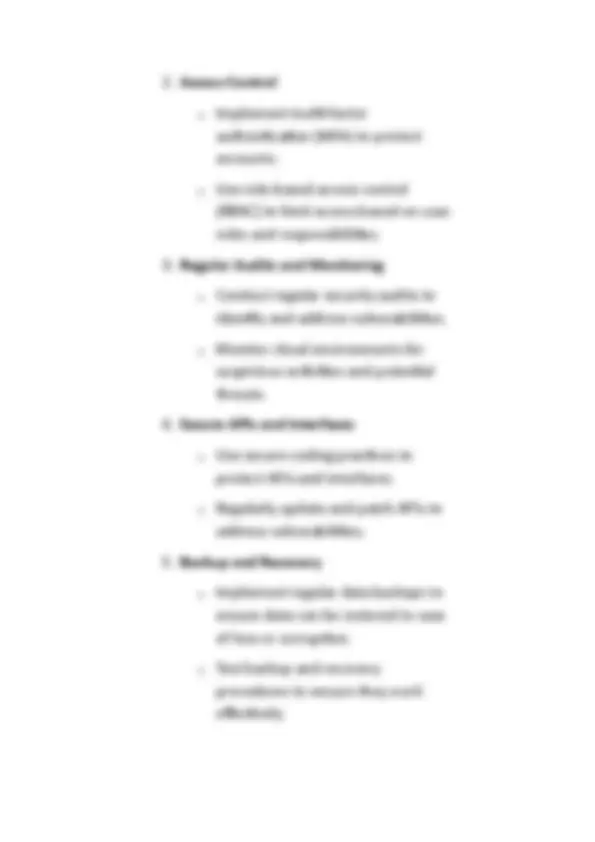Download Microsoft ebooks for your information and more Thesis MS Microsoft Office skills in PDF only on Docsity!
"Cloud Computing Simplified"
Index for "Mastering Cloud Computing: Concepts, Techniques, and Applications"
1. Introduction o Overview of Cloud Computing o Importance and Impact of Cloud Computing o **Structure of the Book
- Chapter 1: Fundamentals of Cloud** Computing o Definition and Types of Cloud Computing o History and Evolution o Key Concepts and Terminologies o **Benefits of Cloud Computing
- Chapter 2: Cloud Service Models** o Infrastructure as a Service (IaaS) o Platform as a Service (PaaS) o Software as a Service (SaaS) o Comparison of Service Models
7. Chapter 6: Cloud Service Providers o Overview of Leading Cloud Providers (AWS, Azure, Google Cloud) o Comparison of Features and Services o Case Studies of Cloud Provider **Implementations
- Chapter 7: Migrating to the Cloud** o Cloud Migration Strategies o Planning and Execution o Challenges and Solutions o Cost Management in Cloud **Migration
- Chapter 8: Cloud Management and** Monitoring o Tools and Techniques for Cloud Management o Performance Monitoring and Optimization o Automating Cloud Operations o **Resource Management
- Chapter 9: Advanced Cloud** Computing Concepts o Serverless Computing
o Containerization and Kubernetes o Edge Computing o Machine Learning in the Cloud o Internet of Things (IoT) Integration
11. Chapter 10: Ethical Considerations and Challenges o Data Privacy and Security o Fair Use and Resource Allocation o Transparency and Accountability o Bias and Fairness in AI and Machine Learning o **Ethical Use of Cloud Services
- Chapter 11: Conclusion** o Recap of Key Points o Future Directions in Cloud Computing o Final Thoughts Chapter 1: Fundamentals of Cloud Computing Cloud computing is a transformative technology that offers on-demand delivery of various computing services over the internet.
Types of Cloud Computing
- Public Cloud o Services are delivered over the public internet and shared among multiple organizations.
o Examples: Amazon Web Services (AWS), Microsoft Azure, Google Cloud Platform.
- Private Cloud o Services are maintained on a private network, providing more control and security. o Examples: Internal corporate clouds, dedicated data centers.
- Hybrid Cloud o Combines public and private clouds, allowing data and applications to be shared between them. o Examples: A company uses private cloud for sensitive data and public cloud for scalable resources.
- Community Cloud o Shared infrastructure for a specific community of users with common concerns. o Examples: Government agencies sharing resources and compliance requirements.
Key Concepts and Terminologies
- Virtualization: Creating virtual versions of physical resources, allowing multiple virtual machines to run on a single physical machine.
- Scalability: The ability to increase or decrease resources as needed to handle varying workloads.
- Elasticity: The ability to automatically scale resources up or down based on demand.
- Pay-as-You-Go: Billing model where users are charged based on actual resource usage.
- Multi-Tenancy: Multiple customers share the same physical infrastructure while keeping their data isolated.
o Allows for quick scaling of resources to meet changing demands. o Provides flexibility to access resources from anywhere with an internet connection.
- Disaster Recovery o Offers robust backup and recovery solutions, minimizing downtime and data loss. o Ensures business continuity in case of disasters.
- Collaboration o Enhances collaboration by providing access to shared data and applications. o Facilitates real-time collaboration among team members, regardless of location.
- Innovation o Facilitates rapid deployment of new services and applications. o Encourages experimentation and innovation with minimal upfront costs.
Understanding these fundamentals lays the groundwork for exploring more advanced topics and practical applications of cloud computing. It sets the stage for a deeper dive into the various aspects of cloud services, architecture, security, and more in the following chapters.
- Hosting websites and applications.
- Storage and backup solutions.
- High-performance computing. Platform as a Service (PaaS) PaaS provides a platform that allows developers to build, deploy, and manage applications without worrying about the underlying infrastructure. It includes
development tools, middleware, and database management systems. Features:
- Pre-configured development environment.
- Supports multiple programming languages and frameworks.
- Automates infrastructure management tasks. Examples:
- Google App Engine.
- Microsoft Azure App Service.
- Heroku. Use Cases:
- Developing web and mobile applications.
- API management.
- Data analytics and machine learning.
- No need for software installation or maintenance.
- Regular updates and security patches provided by the service provider. Examples:
- Google Workspace (formerly G Suite).
- Microsoft Office 365.
- Salesforce. Use Cases:
- Email and collaboration tools.
- Customer relationship management (CRM).
- Project management and productivity software.
Comparison of Service Models Servic e Model Features Examples Use Cases IaaS Virtualized computing resources, user- managed OS
AWS EC2,
Azure VMs, Google Hosting, storage, high- performance computing




































































































































































